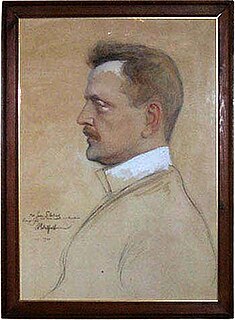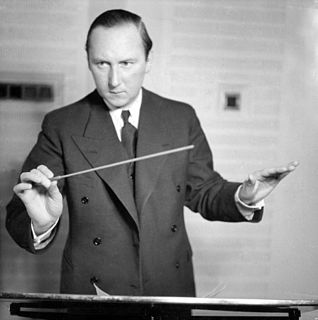Related Research Articles

In music, a cadenza is, generically, an improvised or written-out ornamental passage played or sung by a soloist or soloists, usually in a "free" rhythmic style, and often allowing virtuosic display. During this time the accompaniment will rest, or sustain a note or chord. Thus an improvised cadenza is indicated in written notation by a fermata in all parts. A cadenza will usually occur over the final or penultimate note in a piece, the lead-in or over the final or penultimate note in an important subsection of a piece. It can also be found before a final coda or ritornello.

The Violin Concerto in D major, Op. 61, was written by Ludwig van Beethoven in 1806. Its first performance by Franz Clement was unsuccessful and for some decades the work languished in obscurity, until revived in 1844 by the then 12-year-old violinist Joseph Joachim with the orchestra of the London Philharmonic Society conducted by Felix Mendelssohn. Joachim would later claim it to be the "greatest" German violin concerto. Since then it has become one of the best-known and regularly performed violin concertos.

The Violin Concerto in D minor, Op. 47 of Jean Sibelius, originally composed in 1904 and revised in 1905, is the only concerto by Sibelius. It is symphonic in scope and included an extended cadenza for the soloist which takes on the role of the development section in the first movement.
John Harris Harbison is an American composer, known for his symphonies, operas, and large choral works.
Richard Danielpour is an American composer.
The Albany Symphony Orchestra is a professional symphony orchestra based in Albany, New York.
Margaret Brouwer is an American composer and composition teacher. She founded the Blue Streak Ensemble chamber music group.
Nikolai Petrovich Rakov, was a Soviet violinist, composer, conductor, and academic at the Moscow Conservatory where he had studied. He composed mostly instrumental works, for orchestra, chamber music and piano music, especially pedagogic works. In 1946, he received the Stalin Prize for his first violin concerto, which became known internationally.
Jennifer Higdon's Concerto for Violin and Orchestra was written in 2008. The work was jointly commissioned by the Indianapolis Symphony Orchestra, the Toronto Symphony Orchestra, the Baltimore Symphony Orchestra, and the Curtis Institute of Music. It was composed for the violinist Hilary Hahn and was given its world premiere by Hahn and the Indianapolis Symphony Orchestra under the conductor Mario Venzago on February 6, 2009. The piece was later awarded the 2010 Pulitzer Prize for Music.
Notes on Light is a cello concerto by the Finnish composer Kaija Saariaho. The work was commissioned by the Boston Symphony Orchestra and was first performed at Symphony Hall, Boston on February 22, 2007, by the cellist Anssi Karttunen and the Boston Symphony Orchestra under the conductor Jukka-Pekka Saraste.
The Cello Concerto No. 3, Legend of the Phoenix, is a composition for cello solo and orchestra by the American composer Augusta Read Thomas. The work was commissioned by the Boston Symphony Orchestra with contributions from Bill and Solange Brown. It was first performed in Boston on March 14, 2013, by the cellist Lynn Harrell and the Boston Symphony Orchestra under the conductor Christoph Eschenbach. Thomas subsequently adapted the piece into a viola concerto in 2013.
The Concerto for Horn and Orchestra is a horn concerto by the American composer Elliott Carter. The work was commissioned by the Boston Symphony Orchestra for the horn player James Sommerville. It was first performed on November 15, 2007 in Boston by Sommerville and the Boston Symphony Orchestra under the conductor James Levine.
Interventions is a composition for solo piano and orchestra by the American composer Elliott Carter. The work was composed at the behest of the pianist Daniel Barenboim and the conductor James Levine to celebrate Carter's 100th birthday. The piece was completed on April 16, 2007 and was first performed in Symphony Hall, Boston on December 4, 2008 by Daniel Barenboim and the Boston Symphony Orchestra under James Levine.
The Symphony No. 5 is a composition for baritone, mezzo-soprano, and orchestra by the American composer John Harbison. The work was commissioned by the Boston Symphony Orchestra under the conductor James Levine. It was given its world premiere in Boston on April 17, 2008 by the mezzo-soprano Kate Lindsey, the baritone Nathan Gunn, and the Boston Symphony Orchestra directed by James Levine. The text of the piece is set to Orpheus and Eurydice by Czesław Miłosz, Relic by Louise Glück, and the Sonnets to Orpheus by Rainer Maria Rilke.
The Oboe Concerto is a composition for solo oboe and orchestra by the American composer John Harbison. The work was commissioned by the San Francisco Symphony for its principal oboist William Bennett. It was completed on October 18, 1991, and was given its world premiere by Bennett and the San Francisco Symphony under the conductor Herbert Blomstedt in 1992.
The Concerto for Viola and Orchestra is a viola concerto by the American composer John Harbison. The work was commissioned by the Saint Paul Chamber Orchestra, the Los Angeles Chamber Orchestra, and the New Jersey Symphony Orchestra with contributions from Meet The Composer and Reader's Digest. It was first performed by Jaime Laredo and the New Jersey Symphony Orchestra under the direction of Hugh Wolff on May 18, 1990.
The Piano Concerto No. 1 is a composition for solo piano and orchestra by the American composer Peter Lieberson. The work was commissioned by the Boston Symphony Orchestra for its centennial. Lieberson started composing the piece in 1980 and completed it on March 2, 1983. It was written for the pianist Peter Serkin, who first performed the concerto with the Boston Symphony Orchestra under the direction of Seiji Ozawa on April 21, 1983. The piece is dedicated to Peter Serkin and Seiji Ozawa. It was a finalist for the 1984 Pulitzer Prize for Music.
The Double Concerto is a composition for violin, cello, and orchestra by the American composer Ned Rorem. The work was commissioned by the Indianapolis Symphony Orchestra and composed between July 27, 1997 and April 1998. It was composed for the violinist Jaime Laredo and the cellist Sharon Robinson, who first performed the piece with the Indianapolis Symphony Orchestra conducted by Raymond Leppard in Indianapolis on October 15, 1998.

The Violin Concerto, Op. 54, is a three-movement concertante composition for violin and orchestra written in 1952 by the Swedish composer Lars-Erik Larsson. The piece premiered over Swedish Radio on 11 January 1953 in Stockholm, Sweden, with Sten Frykberg conducting the Swedish Radio Orchestra. The soloist was the Hungarian violinist André Gertler, its dedicatee.
References
- 1 2 3 Harbison, John (2009). "Double Concerto". G. Schirmer Inc. Retrieved April 30, 2016.
- ↑ Eichler, Jeremy (February 7, 2010). "Honey, please pass the melody: Husband and wife team take on Harbison's new Double Concerto". The Boston Globe . Retrieved April 30, 2016.
- ↑ Eichler, Jeremy (April 9, 2010). "BSO unveils new Harbison for husband and wife". The Boston Globe . Retrieved April 30, 2016.